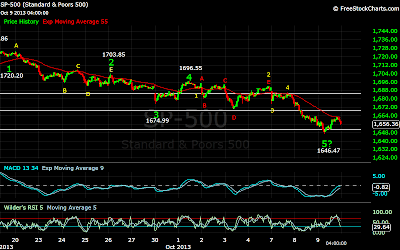Last Friday the SPX opened slightly lower, and
then rallied to 1703.44. After a slight pullback, the index tested that high,
but failed to surpass it. This was right at the 1703 resistance level. After
failing to move above that resistance, the SPX opened sharply lower this
morning, dropping to 1692.13 a few minutes after the open. This represented the
largest pullback since this move higher began at 1646.47. That proved to be the
low for the day, as the index continued to move relentlessly higher from that
low, with the SPX moving above the 1703 resistance level, and continuing higher
to 1711.03. From there the index moved slightly lower into the close.
The action today, after the 1692.13 morning low,
looks like 4 waves higher, with an inverted corrective wave 2. I would project
wave 5 of this sequence to end between 1711 and 1713. If my count from the
1646.47 low is correct, this should complete wave B of an inverted corrective
wave 2. I have wave 1 as being the move from 1646.47 to Wednesday’s 1662.47
high. Wave A of the inverted corrective wave was the move from that high to
1654.81. The SPX has been in wave B of 2 since that point. If this is correct,
the index should move slightly higher, to between 1711, and 1713, and then
experience a pullback. Since this has not yet completed a 5 wave sequence from
the 1646.47, I still expect the index to move higher, with 1745 being a likely
target. If the SPX moves above 1713 without a pullback, another count may come
into play that would target a high near 1740.
Starting last Monday, I have been mentioning that
my longer term count from 1074.77 still requires some work to the upside to
complete. As a picture is sometimes easier to visualize than words I have
included a chart showing how I see this wave completing. This should not be
taken as target prices or times, but simply the waves need to complete the
sequence. By my count, the SPX is in Wave D of 2 from 1074.77. Again, these
waves can complete in several ways, so these are not meant to be targets.
It is interesting to compare this chart to the chart
from October 2002 until October 2007. The two are strikingly similar, and
again, serves as a visualization as to how this wave will complete.








